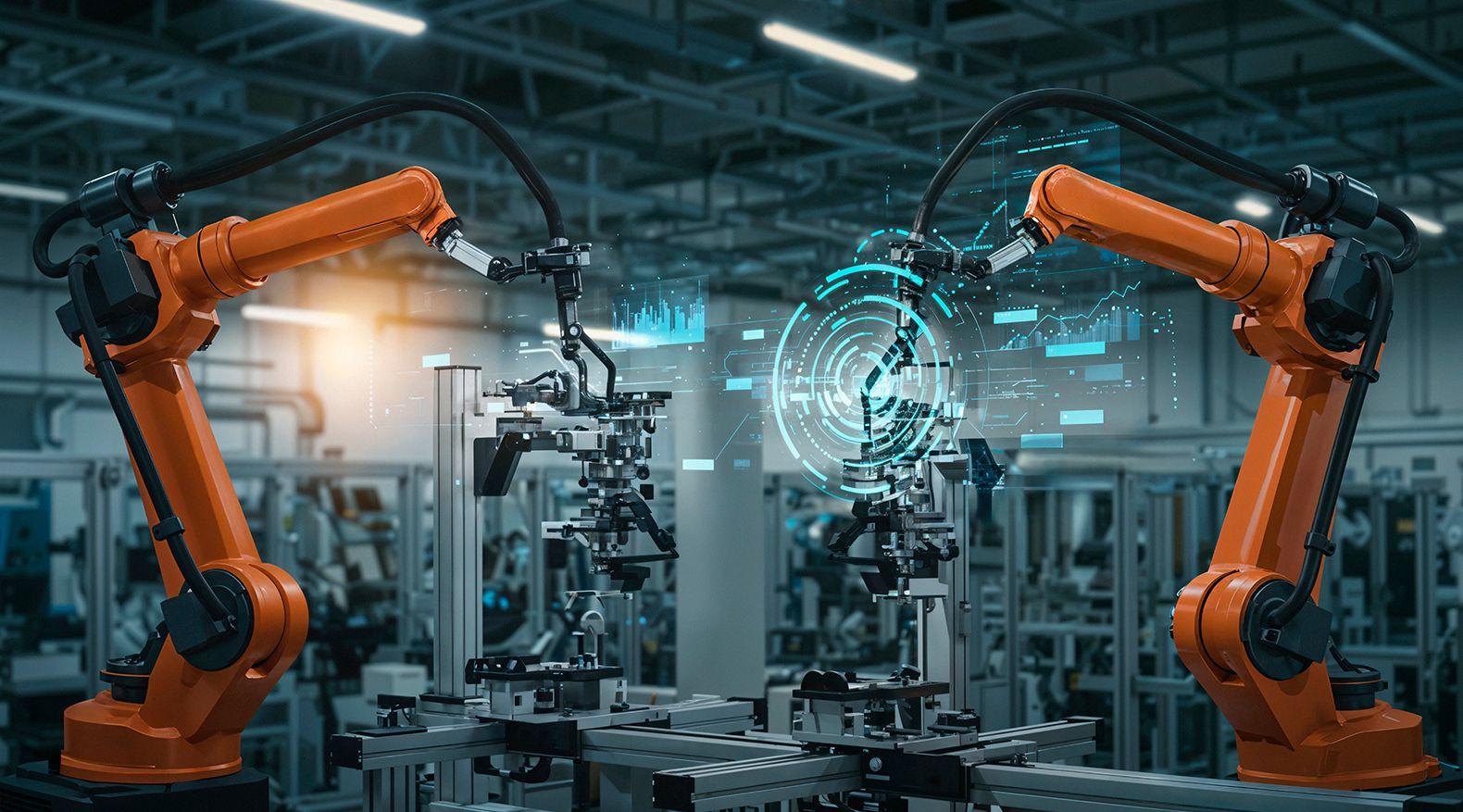AI in Industrial Automation: How AI is Transforming Industries

In today’s fast-evolving digital landscape, AI in industrial automation is no longer a futuristic concept — it's a powerful reality reshaping how industries operate. From predictive maintenance to AI-powered production, artificial intelligence is revolutionizing every function in the industrial world. But what exactly does this transformation entail, and how are companies adapting?
This blog post will take you on a detailed journey into how artificial intelligence in manufacturing is creating smarter, more efficient, and agile industrial processes. Moreover, we’ll explore real-world applications, the advantages of industrial AI, and how smart factories are becoming the new standard.
The Evolution of Industrial Automation
Before we dive into the impact of AI, it’s important to understand where industrial automation started.
Traditionally, automation in industries relied heavily on rigid systems like programmable logic controllers (PLCs), fixed mechanical equipment, and time-consuming manual inputs. However, these systems, while efficient in repetitive tasks, lacked flexibility and adaptability. As industrial demands grew more complex, these traditional solutions began showing limitations.
Then came Industry 4.0, which brought with it a slew of technologies including the Internet of Things (IoT), cloud computing, and, most critically, artificial intelligence. AI emerged as a game changer, capable of learning, adapting, and optimizing without human interference. Consequently, it began playing a central role in automating not just processes but also decision-making across industries.
What is AI in Industrial Automation?
Simply put, AI in industrial automation refers to the integration of machine learning algorithms, computer vision, neural networks, and robotics into industrial systems to optimize performance, reduce downtime, and increase efficiency.
However, unlike traditional automation systems that follow predefined instructions, AI systems can analyze large data sets, detect patterns, and make autonomous decisions. In other words, they bring a level of intelligence and adaptability that traditional systems cannot match.
For instance, while a traditional machine might need manual adjustment for each product variation, an AI-powered system can adapt on-the-fly based on real-time data — improving speed, consistency, and precision.
Core Benefits of AI-Powered Production
So, what makes AI-powered production such a big deal in manufacturing and beyond?
1. Predictive Maintenance
Predictive maintenance is arguably one of the most important uses. Systems can anticipate when equipment will break and plan maintenance before it really occurs by using AI and machine learning techniques.
This prolongs the life of machines and avoids expensive downtime. McKinsey claims that predictive maintenance can cut unplanned outages by up to 50% and maintenance expenses by 20%. As a result, in industries like automotive and aerospace, this benefit alone can result in savings worth millions annually.
2. Quality Control Through Computer Vision
Another potential benefit of AI in industrial automation lies in quality assurance. For instance, using computer vision, AI systems can inspect products on the production line far more accurately than human eyes or traditional sensors.
These systems can detect:
-
Surface imperfections like dents, cracks, or scratches
-
Color mismatches or incorrect labeling
-
Assembly misalignments
-
Irregular shapes or dimensions
Furthermore, what makes AI superior is its ability to learn and improve over time. The more images or data it processes, the better it becomes at spotting inconsistencies. Moreover, these systems can work 24/7 without fatigue, maintaining consistent quality across large volumes of production.
3. Process Optimization
AI also plays a crucial role in streamlining operations. It analyzes data from various stages of the manufacturing process to identify inefficiencies and suggest improvements. These might include bottlenecks in assembly lines, underutilized machines, or excessive energy consumption.
Once identified, the AI system doesn’t just highlight the issue — it recommends or even automatically implements improvements. For example:
-
Adjusting the speed of conveyor belts to balance the production load
-
Modifying machine parameters to reduce energy usage
-
Reallocating tasks between robotic arms to speed up operations
Additionally, AI can mimic various production scenarios using digital twins, which are virtual representations of physical assets and systems. Manufacturers can test process modifications in a digital environment before implementing them in the real world, reducing risk and downtime.
4. Demand Forecasting and Inventory Management
AI doesn't just help with what's happening inside the factory — it also improves how products get to customers.
Artificial intelligence (AI) systems are able to forecast more accurately product demand than conventional techniques by examining past sales data, market trends, seasonal demand patterns, and even weather forecasts. These observations benefit manufacturers:
-
Optimize production schedules
-
Reduce excess inventory
-
Prevent stockouts
-
Improve customer satisfaction
Moreover, AI can manage supply chain logistics in real time. For instance, if a supplier delays a shipment of raw materials, the AI system can quickly adjust production timelines or reroute sourcing to alternate vendors — all without waiting for human intervention.
Real-World Industrial AI Applications
Across the globe, companies are already leveraging industrial AI applications to gain a competitive edge.
1. Siemens and Smart Manufacturing
Siemens has been at the forefront of implementing artificial intelligence in manufacturing. Their AI-based predictive analytics help detect anomalies in production equipment, preventing failures before they occur. Furthermore, Siemens uses digital twins — virtual models of physical assets — powered by AI to simulate and optimize production processes.
2. Tesla’s AI-Integrated Production Line
Tesla’s Gigafactories are prime examples of AI-powered production. Robots with embedded AI manage complex tasks such as battery assembly and quality checks. These intelligent systems help speed up production while maintaining top-tier product quality.
3. GE’s Use of Industrial AI for Maintenance
General Electric utilizes AI for predictive maintenance in its aviation and energy divisions. Their industrial equipment is embedded with sensors that feed real-time data into AI algorithms, enabling preemptive repairs and maximizing equipment uptime.
The Rise of Smart Factories
The era of smart factories is upon us; they are highly automated, data-driven settings where people, machines, and systems work together harmoniously.
These factories use AI to make real-time decisions, automate workflows, and enhance production agility. Key technologies include:
IoT Sensors: Collecting data on everything from machine performance to environmental conditions.
Cloud Platforms: Storing and analyzing massive amounts of data.
AI Algorithms: Learning from data to predict trends and optimize decisions.
In smart factories, everything is connected. For instance, if a sensor detects that a part is wearing out, the AI system can automatically adjust the workflow, reorder the part, and schedule a maintenance technician — all without human intervention.
Not only do smart factories increase efficiency, but they also improve worker safety by identifying risks before accidents happen.
Challenges in Implementing AI in Industrial Automation
Despite its numerous benefits, integrating AI into industrial automation comes with challenges.
1. Data Quality and Integration
AI systems require vast amounts of high-quality data to function effectively. Many legacy systems in factories aren't equipped to provide the necessary data, making integration complex and time-consuming.
2. Workforce Adaptation
As AI takes over more responsibilities, the workforce must adapt. Furthermore, this does not indicate massive job losses but rather a shift in employment functions. Workers, for example, will need training in AI management, data analysis, and system maintenance.
3. Cybersecurity Concerns
As more devices become connected, the risk of cyberattacks increases. Therefore, AI systems that control critical infrastructure must be safeguarded through advanced cybersecurity protocols, requiring ongoing investment.
Nevertheless, companies that overcome these hurdles stand to gain massively in productivity, cost savings, and innovation.
The Future of Artificial Intelligence in Manufacturing
In the future, artificial intelligence will continue to become increasingly important in manufacturing. Observe the following trends:
1. Collaborative Robotics (Cobots)
Cobots are AI-driven robots made to assist human operators. These machines can learn from human behavior and assist with physically demanding or repetitive tasks, enhancing worker productivity and safety.
2. AI-Driven Supply Chains
Supply chains will become smarter, faster, and more resilient. As a result, AI will forecast demand, manage inventory, and even predict disruptions like natural disasters or geopolitical events — all in real time.
3. Sustainable Manufacturing
AI can help companies reduce waste, optimize energy consumption, and shift toward sustainable practices. From smart grids to carbon footprint tracking, AI will be a crucial ally in making manufacturing more sustainable and greener.
Building the AI-Ready Industry
To truly harness the power of AI in industrial automation, industries must prepare themselves for digital transformation. This includes:
-
Investing in AI infrastructure like data lakes, edge computing, and cloud platforms.
-
Training employees to understand, operate, and innovate using AI tools.
-
Partnering with AI vendors and startups to bring in fresh insights and technologies.
Additionally, companies need to develop an action plan that synchronizes AI capabilities with corporate objectives. This optimizes the return on AI investments and guarantees a seamless transition.
Conclusion: Embracing AI-Driven Innovation
In summary, AI in industrial automation is not just enhancing how we produce goods — it's reshaping the very core of industrial strategy. From predictive maintenance and real-time quality control to fully autonomous smart factories, artificial intelligence is enabling businesses to become faster, smarter, and more efficient.
Although challenges remain, the rewards of embracing AI-driven innovation far outweigh the risks. All in all, industries that act today will be the leaders of tomorrow, setting benchmarks in efficiency, sustainability, and innovation.
As we move deeper into the era of intelligent machines and data-driven decisions, one thing is certain: the future of industry belongs to AI.
